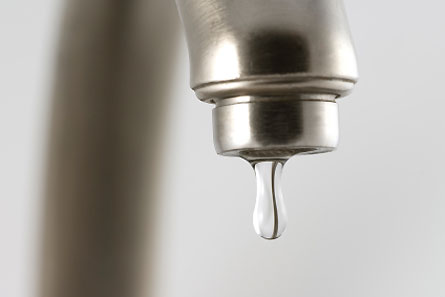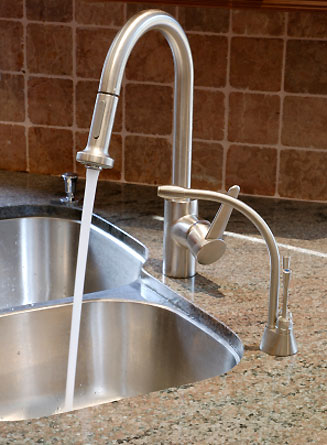Faucets Destined for Brassy Changes
Yesterday I noted how a major university stumbled onto a big lead-in-water problem plaguing what turned out to be every new building on campus. The problem traces to the brass used in faucets and fountains that dispense drinking water.


When Carolyn Elfland, an associate vice chancellor at the University of North Carolina got sucked into redressing this problem two years ago, she didn’t know much about brass. She’s since had a crash course and can now cite you chapter and verse on industry plumbing standards, both as they now exist and as they’re are slated to change soon. Just not too soon.
The reason plumbing fixtures still contain lead is that it makes the brass easier to machine, explains Marc Edwards of Virginia Tech in Blacksburg. “There are alternatives,” he says. “Unfortunately, each time they identify one, its price skyrockets. So [the industry is] still putting lead into brass.” Concentrations of up to eight percent of the brass (by weight) can be lead, he notes — at least as long as the fixture won’t leach more than 11 parts per billion lead into the water passing through it. (That allowable limit drops to 5 ppb in 2012.)
But that limit doesn’t apply to all water. Just the water passing through sample fixtures during industry certification tests. And to make sure that each fixture faces the same challenge, the water’s recipe must be carefully duplicated each time.
Unfortunately, Edwards says, “We showed a few years ago how those performance standards were very, very lax.” That is, the water wasn’t “aggressive” enough to really threaten much lead leaching. As a result of his team’s publication of those data, NSF International — a nonprofit that helps develop industry standards and product-certification procedures — “actually did tighten the standard up,” Edwards notes. “But it’s going to take quite a while before it’s implemented.”
“It goes into effect in 2012,” Elfland says, “because manufacturers must have time to reformulate their brass.”
But not all plumbing brass must make the switch to lower lead and testing under with more aggressive waters, she notes. Just those designed to dispense drinking water.
I called NSF International today and learned which faucets are exempt from the coming, tighter lead standards. Lead concentrations in plumbing brass (and lead leaching) may legally remain high in faucets used to supply water to: showerheads, bathtubs, washing machines, stationary tubs (also known as slop sinks, where people might wash hands and paint brushes) and outdoor hoses (such as those used to wash a car, fill a swimming pool, or slake the thirst of lawns and gardens). Also on this exemption list: metered or sensor-driven faucets in public bathrooms (because they’ve been designed for washing hands only).
Bottom line: People should never use these exempt faucets to fill up a drinking glass, tea kettle, or pot that will be used to cook pasta. And yes, that means you shouldn’t be drinking out of the garden hose (although they tend to be so dirty, why would someone in their right mind even want to).
While learning all of this, Elfland ran across mention of a more restrictive lead standard for drinking water fixtures used in California. Unlike the national lead-leaching limit of 11 ppb, she was told that these weren’t supposed to leach more than 5 ppb.
While awaiting NSF’s new 2012 standards to go into effect, she thought it might make sense for her university to buy those California-certified faucets and drinking fountains. But to her surprise, she told me, some of the fixtures that had been leaching lead badly in UNC’s new buildings had been sanctioned for use in California.
What’s up?
I called the California State EPA’s Office of Environmental Health Hazard Assessment late yesterday to ask. I’d been told the California fixtures were known as “Proposition 65-compliant” faucets and drinking fountains. Only the Prop 65 Office didn’t know what I was talking about.
Mandi Bailhache, a legislative analyst in that office told me that Prop 65 just requires a warning label on products that may contain hazardous constituents (such as lead). However, she was nice enough to refer me to a California bill that appears to have passed into law earlier this year (i.e. on or shortly after Aug. 12).
It says that after January 1, 2010, items intended to convey or dispense drinking water will not be considered “lead free” if they use solder (or flux) containing more than 0.2 percent lead, or if the “wetted surface of pipes and pipe fittings, plumbing fittings, and fixtures” possess a weighted average of lead exceeding 0.25 percent.
Until then, drinking-water fixtures will be deemed leadfree as long as they contain no more than eight percent lead.
No wonder UNC’s California-rated faucets leached as badly as those intended for use elsewhere in the United States.
But don’t you wonder why someone hasn’t made a big ruckus yet about why drinking-water faucets can remain on the market when they might pose substantial lead-poisoning risks, as the UNC case-study demonstrates?
A truer “leadfree” brass may cost more, but what price can we put on the health of our children. Excess lead can diminish the IQ of children, stunt their growth, and harm their hearing. There’s a reason we took the lead out of paint and gasoline. Can’t a similar case be made for accelerating its removal from plumbing fixtures?
Or we could ask regulators to take a different interim tack: Ask water utilities to do for their customers what Marc Edwards did for UNC: test how aggressive their waters are — and where it risks leaching lead, develop some conditioning protocol that businesses and homeowners could use in the first few days after installing new fixtures.
Now that would be a public service.






